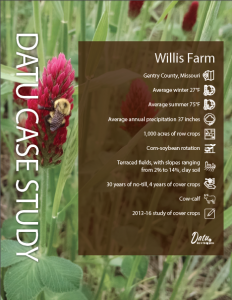Research conducted by NACD and Datu Research found that corn and soybean farmers who use cover crops and/or no-till can improve their bottom lines by over $100 per acre (read the full press release here). Read about the economic and soil health benefits of using these conservation practices in the four case studies below. Each case study includes year-to-year budget data, as well as real farmer insights on why and how to use no-till and cover crops.
Four farmers in the Upper Mississippi River Basin found that soil health practices:
- Cut fertilizer costs by up to $50 per acre;
- Cut erosion repair costs by up to $16 per acre; and
- Increased yields by up to $76 per acre.
Case Studies
Click the cover page of a case study below to get reading:
Diaz Farm at a Glance
Stephenson County, Illinois • Average winter 22°F • Average summer 70°F • Average annual precipitation 38 inches • 25 acres of row crops • Corn-soybean rotation • Gentle rolling terrain with slopes ranging from 3% to 5%, whole farm classified as highly erodible areas, silt loam soil • 26 years of no-till, 5 years of cover crops
Key Lessons from Diaz’s Experiment
The initial investment in learning paid off. • The variety of cover crop seed used can dramatically alter both the budget and benefits. • In three years, cover cropping cut the need for erosion-related repairs. • Routine use of cover crops increases overall farm resilience.
Willis Farm at a Glance
Gentry County, Missouri • Average winter 27°F • Average summer 75°F • Average annual precipitation 37 inches • 1,000 acres of row crops • Corn-soybean rotation • Terraced fields, with slopes ranging from 2% to 14%, clay soil • 30 years of no-till, 4 years of cover crops • Cow-calf
Key Lessons from Willis’s Experiment
Devote time to learning about cover crops before trying them on the farm. • Start small, adding more acres each year to decrease risk and learn from experience. • Save money by joining conservation incentive programs and grazing cattle on cover crops.
![]() Moore Farm at a Glance
Moore Farm at a Glance
Howard County, Iowa • Average winter 17° F • Average summer 70° F • Average annual precipitation 40 inches • 2,300 acres of row crops • Corn-soybean rotation • Mostly loam soil, generally slopes of 2-5% with a few areas of 4-7% • 25 years of no-till, 3 years of cover crops
Key Lessons from Moore’s Experiment
Although some experts have said this region is too far north for cover crops, careful and thorough management of the process can make them work. • Cover crops have helped decrease white mold in soybeans and weed pressure • Using cover crops makes landowners more likely to rent to you, because they can see that you will be taking care of their land.
Kuhns Family Farm at a Glance
Effingham County, Illinois • Average winter 31°F • Average summer 75°F • Average annual precipitation 44 inches • 1,800 acres of row crops • Corn-soybean rotation • Silt loam soils, flat with slopes ranging from 1% to 10% • 23 years of no-till • Farrow-to-finish hog operation
Key Lessons from Kuhns’s Experiment
The time saved by switching to no-till can be devoted elsewhere, including to his hog operation and his family. • During stressful years, the effects of increases in organic matter and the reservoir of water in his soils returned significant benefits. • Starting the no-till transition on soybean fields made it easier than on corn fields because soy requires fewer changes in machinery and management.





